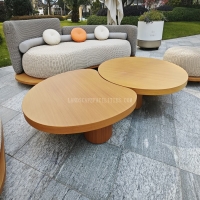Welcome to the website for landscape facilities products and knowledge.
How does the table’s design support the mental and physical well-being of users during long meetings?
In today's fast-paced corporate environment, extended meetings have become inevitable, making table design crucial for maintaining user well-being. Modern conference tables incorporate sophisticated ergonomic principles that address both physical comfort and mental engagement throughout lengthy sessions.
The physical dimension of table design begins with adjustable height mechanisms, allowing users to alternate between sitting and standing positions. This dynamic postural change prevents spinal compression and improves blood circulation, significantly reducing musculoskeletal strain. Tables with rounded edges eliminate pressure points on wrists and forearms, while strategically placed legroom accommodates various body types without restricting movement.
Beyond physical comfort, table layouts profoundly impact psychological engagement. Curved and oval designs foster better eye contact and group interaction, combating meeting fatigue through enhanced social connection. Integrated cable management systems maintain visual clarity, reducing cognitive load from cluttered workspace. Some advanced tables even incorporate built-in power outlets and wireless charging pads, eliminating the anxiety of device battery depletion during critical discussions.
Material selection plays a subtle yet significant role in mental well-being. Natural wood finishes and matte surfaces minimize glare and visual stress, while sound-absorbing materials create acoustically comfortable environments that reduce listening fatigue. The incorporation of biophilic elements through wood grains or nature-inspired patterns has been shown to lower stress levels and improve creative thinking.
Smart tables now incorporate technology integration zones that keep devices accessible yet organized, preventing the physical clutter that often leads to mental distraction. These designated areas for laptops and tablets encourage proper screen positioning that reduces neck strain while maintaining collaborative visibility.
The most innovative designs include micro-environments for individual users within the collective space—personal light controls, temperature zones, and customizable surface areas that empower users to create their ideal working conditions. This sense of environmental control has been directly linked to reduced meeting fatigue and increased participation quality.
Ultimately, well-designed meeting tables function as active well-being tools rather than passive surfaces. They acknowledge the human factors in prolonged intellectual work—from promoting physical movement to facilitating natural social dynamics—transforming necessary long meetings from endurance tests into productive, comfortable experiences that respect both body and mind.
Related search:

Recommendation
Elliptical metal outdoor table with nested design, resembling wood grain, round table